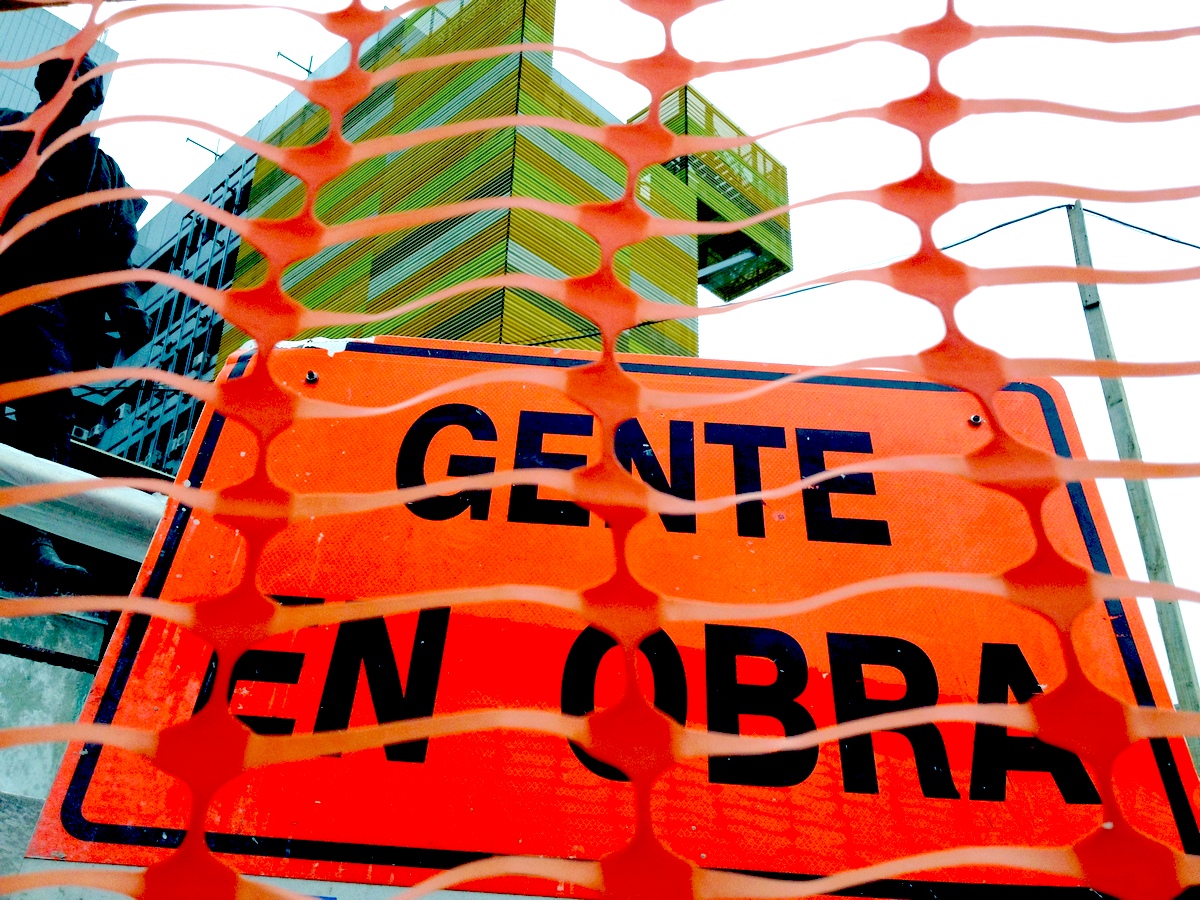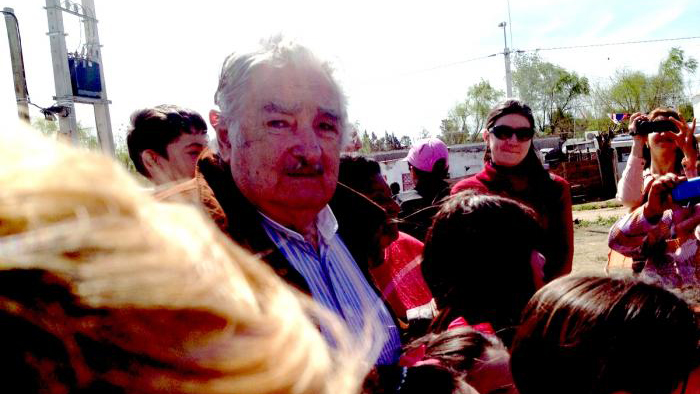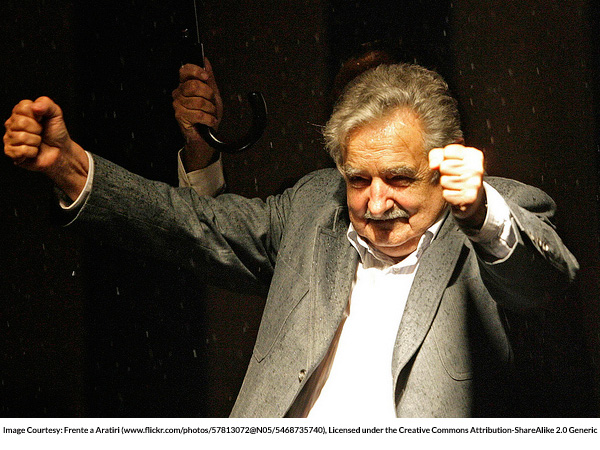
In an uncharacteristically gloomy part of Montevideo, Uruguay—where the city's astonishing Art Deco architecture melts into a disordered, postwar litter of now-tarnished skyscrapers and empty lots—stands a nine-story structure surrounded by cranes. You wouldn't know it from the street—opaque construction fences and a confetti of orange temporary fencing obstructs a clear view—but this structure is the heart of the nation. Or it represents it, standing for the dark weight of its history and dreams of rebirth imagined, blueprinted, but still not completed.
In the late 1970s, the brutal military dictatorship that ruled over Uruguay designed the building to be its defense ministry, the heart of its brutal project to control speech and action and thought. The dictatorship killed fewer of its wayward citizens than, for instance, the parallel juntas in Chile or Argentina did, but it imprisoned more of them; at points, Uruguay had the highest per capita political incarceration rate of any country in the world. One in 500 Uruguayans spent extended time in prison for political reasons. One in 50 experienced an extended, often frightening interrogation. The new defense ministry, looming and dark, composed of concrete and black paint, was meant to embody in architecture the dictatorship's ambitions to permanence and total power.
Instead, in 1984, kneecapped by an economic crisis, the dictatorship collapsed and was replaced by democracy. The building had never been used as a defense ministry. Nevertheless, it had become a symbol. To represent democracy's triumph over military rule, the subsequent president insisted on using it for his presidential offices. He renamed it Edificio Libertad: the building of freedom.
That president, Julio María Sanguinetti, hailed from a traditional, more right-wing party in Uruguay. In 2004, after 20 years of trying, a left-wing coalition called the Frente Amplio—a motley crew of classical liberals, Communists, and the Tupamaros, a socialist guerrilla force the dictatorship imprisoned—won a national election on the tail end of yet another economic crisis. The coalition vowed to transform the mystical building once more, to make its transfiguration an image of the Uruguayan government's turn from caring for power to caring for the ordinary man. The Frente Amplio declared it would change the Edificio Libertad into a hospital. A public trauma hospital, the country's first. To represent the national healing.
***
"It had to be an absolute metamorphosis!" Thomas Sprechmann, the architect tasked with converting the building to a hospital, declared—and leaned back in his sleek chair, pursed his lips, closed his eyes, tented his knobbly fingers, and drew in a sharp breath through his nose. It was as if the pain of being asked to turn an office building into a hospital was not only still present but actually physical.
Sprechmann specializes in constructing hospitals. He's built 12 big hospitals across Uruguay. In 2007, Uruguay's then-president, an ex-oncologist named Tabaré Vázquez (the first left-wing leader since the dictatorship's end), phoned Sprechmann in the same office where we now sat together, a modish bay of cubicles concealed in a grungy, graffiti-covered townhouse. He asked, Sprechmann remembered, "if it was possible to transform a building of offices into a hospital."
After relating the phone call, Sprechmann paused, raised his eyebrows, and smiled. He has the look of a wise old bird in a children's cartoon, all beaked nose and tufted silver hair and angular cheekbones, and when he raised his fluffy brows the effect was automatically wry. The president's request had almost seemed like a joke, he went on. "It's very difficult, because hospitals are always built as hospitals."
Operating rooms, radiology rooms, ambulance bays: These are all things the would-be defense ministry had never been designed to have. The building's most distinctive original feature was a shooting range in the basement. It was an edifice constructed, quite literally, on violence. As far from a healing center as you can get.
"We had doubts," Sprechmann said.
But the government begged. "The building had a lot of symbolism," Sprechmann explained. "It's a metaphor for the transformation of the country … The dictatorship built it for the military. The next president used it for his offices. Vazquez makes a hospital for the people."
So Sprechmann and his partner—a big, goateed, enthusiastic former architectural student of his, the Penn to his Teller—decided to give it a shot. "We told the president it was possible," the partner, Marcelo Danza, said. One of the first tasks the duo confronted was what to do with something extremely basic: the elevators.
You might not think of it, but architects do, immediately. The elevators in an office building are all wrong for a hospital. Office-building elevators are built only to accommodate people who are standing up. Hospital elevators must accommodate those who lie horizontally: people on gurneys, on their way to the theater. Somehow, Sprechmann and Danza would have to redo the elevator shafts completely while retaining enough of the facade intact to claim it was the same building.
"Would it have been easier to forget about the old building and just build the trauma hospital from scratch?" I asked. It went without asking.
***
In a way, Uruguay's current president, Jose Mujica, faces a task with the Uruguayan nation similar to the one Thomas Sprechmann faces with Edificio Libertad. Mujica's election in 2009 represented the final triumph of the long-suffering Uruguayan left: He had actually been one of the Tupamaros, the legendary left-wing guerillas who played a cat-and-mouse game with the ascendant dictatorship in the '60s. The Tupamaros believed in radical equality and anti-materialism. According to Mauricio Rosencof, a Tupamaro leader who spent a dozen years imprisoned alongside Mujica, the group believed in Che Guevara and Rosa Luxembourg but also in the early Christians, who, Rosencof said, "were sharing everything and each one used just what he needed." They wanted to tear apart the so-called latifundia system whereby 300 families owned a sizable chunk of Uruguay's agricultural land.
Until the dictatorship managed to imprison almost all of them, the Tupamaros' devotion to accomplishing their goal of an anti-materialist revolution was ardent and antic; called "the Robin Hood guerrillas" [CK] by American socialist admirers, they marauded around the country busting money from banks to distribute it to the poor. To express their rage at the corporate takeover of the world, they once bombed a Bayer pharmaceutical plant. They wore wigs, had a flag, and drove a funeral procession into a town to smuggle weapons in for an operation: a Trojan hearse.
When Mujica came to power in 2009, the assumption was that he would make certain kinds of radical changes the Tupamaros had given the best years of their lives to prison for: a more equitable distribution of wealth, for instance, including new taxes on the latifundistas, or sweeping educational reforms to enliven the public school system, which has been leaching students to private education and promoting inequality. That assumption was strengthened by the character of Mujica himself.
Mujica wasn't just any Tupamaro. He is perhaps the Tupamaro who personally follows most devotedly the precepts Rosencof laid out: live simply, with less than you need. Even as he climbed the ranks of politics after his release from prison, he's insisted on driving his own beat-up Beetle to work, wearing a hobo's wardrobe, donating nearly 90 percent of his salary to the poor, and keeping up his little enterprise of farming chrysanthemums on a dumpy commune outside of Montevideo rather than moving to a luxe official residence. Where the Tupamaros had been heroes to a certain segment of the 1960s global far left—"total Samurais, with muscles of steel, mentally alert, instant reflexes, an exact knowledge of weapons and resistance to pain," as described in a 1969 American pamphlet—when he ascended to the presidency Mujica became a modern-day global sensation for his humility and attention to poverty. His personal style has slowly turned him into a cult figure abroad. "Is this the most radical president in the world?" a fawning recent profile in the Guardian asked. Videos of speeches he's given before the United Nations General Assembly and the Rio +20 sustainable development conference, looking charmingly shabby, have racked up well over a million views on YouTube. We're drawn to Mujica because we imagine a figure like him, bravely personally committed to living the values of austerity and environmental care he espouses for the polity, could help us rewind our rush towards Mammon and a SUV-fumes-driven climatic obliteration.
Many Uruguayans hoped for the same thing. "You have to see what it means to be a kid born in a marginalized neighborhood in Uruguay," Adolfo Garcé, a local political scientist, explained. "The distance between the poor son and the kid in a good neighborhood is huge. We see this as a problem."
And yet, like Sprechmann with the Edificio Libertad, Mujica's "hands [are] tied," Garcé added. He's working within the confines of two powerful pre-existing structures. The first is global capitalism. It's not easy for a small country like Uruguay—its population is just under 3.5 million—to opt out. Unable to create a well-diversified local economy, its best hope for growth is to attract foreign investment in a few key industries like cattle ranching and paper milling—which means keeping taxes on corporations and the rich low. And it's not clear if the poor Mujica lionizes want to live simply; they also want access to the consumer goods the rich have been flaunting. To serve the poor within a global consumer culture isn't necessarily compatible with railing against consumerism.
The second structure Mujica works within is fatigue towards revolution. Perhaps we're all dubious of profound change, after a 20th century full of political turmoil. Monuments the dictatorship built for itself exist all over Montevideo; despite how traumatic the period of the dictatorship was, I was surprised to find that nobody has taken them down. In the city's Plaza Independencia, its central square, families lounge with dogs and picnics overtop a sunken shrine to fascistic notions of nationhood the dictatorship created. There is little will, anymore, to tear things apart as the Tupamaros originally wanted to do in the 1960s. The country's previous radical re-imaginings by its leaders exerted too much pain, pain that still lingers beneath the structure of ordinary life, like the buried shooting range that still haunts the foundations of the Edificio Libertad.
During our interview, I learned from Sprechmann's partner, Danza, that the elder architect was himself interrogated by the military police at the start of the dictatorship. It happened in a basketball stadium called the Cilindro. The authorities rounded up dozens of architecture students and professors, along with hundreds of other suspect people like artists or activists, and locked them for two weeks in the stadium while they grilled them on their political beliefs and intentions.
But Sprechmann refused to talk about the episode with me. It wasn't an explicit refusal. Instead, when I began to ask him about it, he'd answer a single question ("How did you sleep?" "Under the bleachers, in sleeping bags") and then excuse himself to go to the bathroom. After an excruciatingly long time, he'd come back in and sit back down in his elegant chair, his lips set tight, his eyes glittering and guarded. Another question ("What time of year were you kept in the stadium?" "October; it was neither cold nor hot") and he'd leave again.
"He didn't want to talk about it," my translator marveled later. Not only did he not want to talk about it. He didn't want to talk about not wanting to talk about it. It was obvious he would prefer to leave that dark floor in his memory untouched.
At the same time as expectations of radicalism hovered around Mujica, in order to reach the presidency at all he had to make various promises that he would leave much in place. For instance, he vowed to keep his predecessor's whole economic team on board—even though that team was considered fairly conservative for Uruguay, classically liberal, favoring tax breaks for foreign investment in paper mills over, say, taxes on the rich. Just as psychologically disturbing as the country's political changes were its periodic economic crises, often tied to catastrophes in neighboring Argentina; everybody has a story from these crises, of seeing impoverished jugglers appear to beg for change on street corners to experiencing unemployment herself. As much as Uruguayans liked to imagine Mujica as a latter-day Robin Hood now grasping the reins, they also expected him to stay the country's pro-growth, decidedly capitalist economic course—anything to prevent a wobble into recession. On education, too, the status quo has proved incredibly difficult to shift. How does a would-be radical president transfigure his nation's culture—while dealing with people's unwillingness to really change? It's what I came to Uruguay to find out.
***
At the end of our interview, Sprechmann and Danza showed me on a computer PowerPoint images of one of the proudest "interventions" they made on the building: the color of the façade. They'd changed part of it from black to yellow. "It's the color of youth!" Danza exclaimed.
They felt certain the yellow would make an impact already. "The building was gray, sad, tough," Sprechmann reflected. "Yellow is the color of happiness!" A shift in tone—to reflect the shift in the leadership tone, now, of Mujica—was one of the most important elements of the work they were doing. "It's as important to change the appearance as what's inside."

Education Resource
Meet the Journalist: Eve Fairbanks
Uruguayan President José Mujica, who lives in penury and drives a battered VW Beetle to better...



